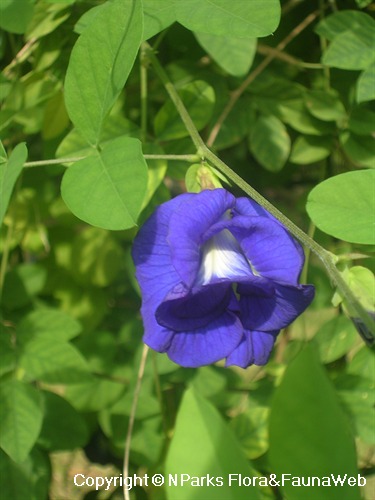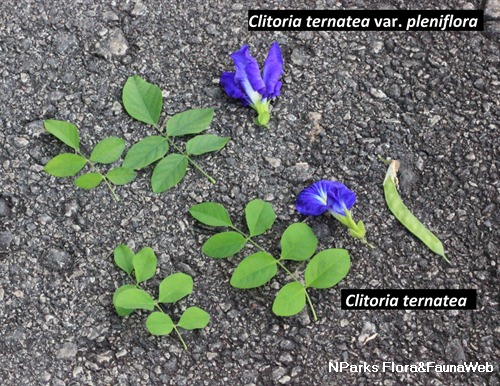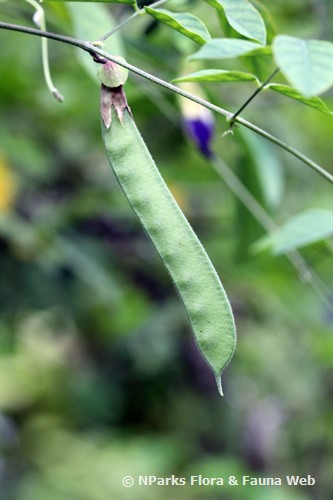.jpg)
Back
Clitoria ternatea Fantz var. pleniflora
| Family Name: | Fabaceae (Leguminosae) |
| Common Name: | Double Butterfly Pea, Double Blue Pea Vine, Double Asian Pigeonwings |
Name
Classifications and Characteristics
| Plant Division | Angiosperms (Flowering Seed Plants) (Dicotyledon) |
|---|---|
| Plant Growth Form | Climber, Herbaceous Plant |
| Lifespan (in Singapore) | Perennial |
| Mode of Nutrition | Autotrophic |
| Plant Shape | Irregular, Leggy |
| Maximum Height | 2 m to 5 m |
| Maximum Plant Spread / Crown Width | 1.5 m |
Biogeography
| Native Habitat | Terrestrial |
|---|---|
| Preferred Climate Zone | Tropical |
Description and Ethnobotany
| Growth Form | A climbing legume with slender and twinning stems. . |
|---|---|
| Foliage | Leaves are compound pinnate, alternately arranged along the stem, with 5 - 7 elliptic to ovate leaflets, measuring 2.5 - 5 cm long and 1.5 - 3.5 cm wide. Each leaflet is thinly papery. |
| Flowers | Flowers are large, deep blue, pea-shaped. Flowers are located on leaf axils. |
| Fruit | Fruits are Fruits are flat dehiscent pods. brown, linear to oblong. Fruit splits open to release 6 - 10 black, oblong seeds. |
| Habitat | Widely distributed throughout the tropics such as disturbed areas, riverine vegetation and grasslands. |
| Cultivation | It is easily grown by seeds. Let pods dry on plant, before collecting seeds for sowing. Fast-growing, but may be attacked by aphids, resulting in plant defoliation. Plant prefers full sun but can tolerate slight semi-shade. |
| Etymology | The genus Clitoria means clitoris, which refers to the flower shape. The specific epithet ternatea means from Ternate, Maluku Islands, Indonesia. Variety pleniflora means multi-petals, in reference to the flowers. |
| Ethnobotanical Uses | Edible Plant Parts : Edible Flowers Others: Flowers are used as dye for colouring food such as Peranakan kueh and nasi kerabu. |
Landscaping Features
| Landscaping | Grown on trellis for attractive purplish-blue flowers with multiple petals. |
|---|---|
| Desirable Plant Features | Ornamental Flowers |
| Landscape Uses | General, Vertical Greenery / Green Wall, Small Gardens, Trellis / Arbour / Pergola, Container Planting |
| Thematic Landscaping | Naturalistic Garden |
Fauna, Pollination and Dispersal
| Fauna Pollination Dispersal Associated Fauna | Butterfly Host Plant |
|---|---|
| Pollination Method(s) | Biotic (Fauna) |
| Seed or Spore Dispersal | Abiotic (Explosive Dehiscence) |
Plant Care and Propagation
| Light Preference | Full Sun |
|---|---|
| Water Preference | Moderate Water |
| Plant Growth Rate | Fast |
| Rootzone Tolerance | Fertile Loamy Soils, Moist Soils, Well-Drained Soils |
| Maintenance Requirements | Moderate |
| Diseases | Under local conditions, may be attacked by aphids, resulting in defoliation. |
| Propagation Method | Seed |
| Planting Distance | 0 |
Foliar
| Foliage Retention | Evergreen |
|---|---|
| Mature Foliage Colour(s) | Green |
| Mature Foliage Texture(s) | Papery |
| Prominent Young Flush Colour(s) | Green |
| Young Flush Texture(s) | Papery |
| Foliar Modification | Foliar Tendril, Stipule |
| Foliar Type | Compound (Odd-Pinnate) |
| Foliar Arrangement Along Stem | Alternate |
| Foliar Attachment to Stem | Petiolate |
| Foliar Shape(s) | Non-Palm Foliage (Ovate, Elliptical) |
| Foliar Venation | Pinnate / Net |
| Foliar Margin | Entire |
| Foliar Apex - Tip | Obtuse |
| Foliar Base | Rounded / Obtuse |
| Typical Foliar Area | Microphyll ( 2.25cm2 - 20.25 cm2 ) |
Non - Foliar and Storage
| Stem Type & Modification | Herbaceous |
|---|---|
| Root Type | Underground (Fibrous Root) |
Floral (Angiosperm)
| Flower & Plant Sexuality | Bisexual Flowers |
| Flower Colour(s) | Blue |
|---|---|
| Flower Texture(s) | Smooth |
| Flower Grouping | Solitary |
| Flower Location | Axillary |
| Flower Symmetry | Bilateral |
| Individual Flower Shape | Papilionaceous / Pea-shaped |
| Flowering Period | Free-Flowering |
| Flowering Opening Time | Daytime |
| Flower Lifespan on Plant | 1 Day |
| Flowering Habit | Polycarpic |
Fruit, Seed and Spore
| Mature Fruit Colour(s) | Brown |
|---|---|
| Fruit Classification | Simple Fruit |
| Fruit Type | Dehiscent Dry Fruit , Legume / Pod |
| Mature Seed Colour(s) | Black |
| Seed Quantity Per Fruit | Moderate (6-10) |
Image Repository
Others
| Master ID | 77 |
|---|---|
| Species ID | 1373 |
| Flora Disclaimer | The information in this website has been compiled from reliable sources, such as reference works on medicinal plants. It is not a substitute for medical advice or treatment and NParks does not purport to provide any medical advice. Readers should always consult his/her physician before using or consuming a plant for medicinal purposes. |

.jpg)




.jpg)

_pauline_tay.jpg)
